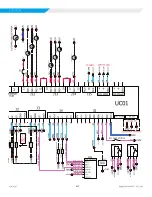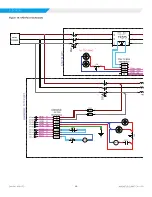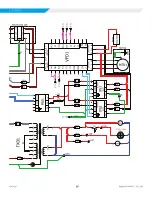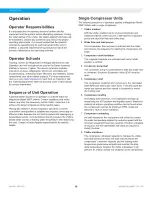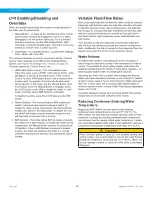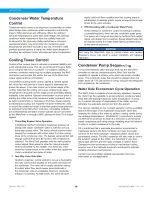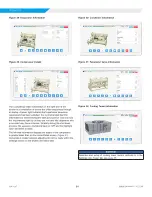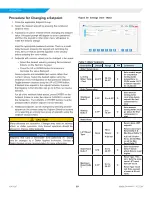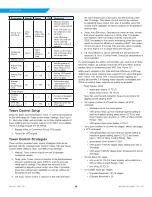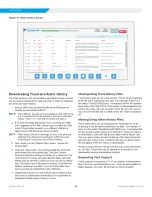
OPERATION
MAGNITUDE WMT CHILLER
DAIKIN APPLIED
28
Condenser Water Temperature
Control
Condenser water control is an important consideration in chiller
plant design since condenser water temperature will directly
impact chiller operation and efficiency. When the ambient
wet bulb temperature is lower than peak design, the entering
condenser water temperature from the cooling tower can
be allowed to fall, improving chiller performance. However,
operational issues may occur when the condenser water
temperatures are either too high or too low. The WMT chiller
provides several options to assist the chiller plant designer in
providing the optimum control of condenser water temperature.
Cooling Tower Control
Control of the cooling tower is required to maintain stability and
avoid operational issues. This can be achieved through a BAS
or by using the MicroTech controller. For systems utilizing a
common condenser water loop for multiple purposes, the BAS
contractor must provide the control but use of the MicroTech
output signal is still recommended.
The preferred cooling tower control utilizes a variable speed
fan. MicroTech will provide a control signal to determine the
proper fan speed. It can also control up to three stages of fan
cycling. Note that fan cycling can cause cooling tower water
temperature to fluctuate as fans stage on/off, potentially adding
instability to the system. Special consideration must be given to
starting the chiller when cold condenser water is present, such
as with inverted starts or changeover from free (tower) cooling
to mechanical cooling. It is required that some method be used
to control the condenser water to maintain proper head pressure
as indicated by the MicroTech controller. Acceptable methods
are outlined below and each of these options can be controlled
by the MicroTech or through a BAS utilizing the MicroTech output
signals.
1 .
Three-Way Bypass Valve Operation
A traditional method for building condenser pressure at
startup with colder condenser water is with the use of a
three-way bypass valve. The device blends warmer water
leaving the condenser with cooler water from the cooling
tower at the condenser inlet. The bypass valve position will
change until full flow from the tower to the condenser is
obtained. The MicroTech provides only the valve position
control signal. Main power to drive the valve’s actuator
must be provided by the installer. The three-way valve
should be located close to the chiller within the equipment
room to minimize the volume of water.
2 .
Two-Way Valve Operation
Another condenser control method is to use a modulating
two-way control valve located on the outlet connection of
the condenser. The valve will be nearly closed at startup
to restrict water flow, which keeps generated heat in
the condenser until an acceptable minimum condenser
pressure is reached. As heat builds, the valve will open
slowly until a full flow condition from the cooling tower is
established. A separate power source is required to provide
power to the valve actuator.
3 .
VFD Operating with a Condenser Water Pump
A third method of condenser control for startup is utilizing
a variable frequency drive with the condenser water pump.
The speed will change as directed by the MicroTech output
signal until design flow is reached. Speed adjustments may
be required during the initial chiller startup as determined
by the service technician.
NOTICE
Not using the MicroTech logic to control valves and variable
frequency drives may result in system instability and capacity
reduction.
Condenser Pump Sequencing
It is recommended to utilize the logic built into the MicroTech
controller to start the condenser pump. MicroTech has the
capability to operate a primary pump and a secondary standby
pump. The condenser water flow should be stopped when the
chiller shuts off. This will conserve energy and prevent refrigerant
from migrating to the condenser.
Water Side Economizer Cycle Operation
The WMT chiller is capable of inverted duty operation, meaning
the chiller has the capability to accept entering condenser water
lower than the leaving evaporator water temperature. In doing
so, it extends the range of applications of the chiller and can
eliminate the waterside economizer from the system.
The savings resulting on the inverted operation can be quantified
with the elimination of the waterside economizer, while also
retaining the ability of the chiller to address cooling needs during
low ambient temperatures. ASHRAE 90.1 prescribes to include
a waterside economizer; so when it is removed, a performance-
based compliance path using energy modeling must be followed
in order to confirm compliance to the code.
If it is confirmed that a waterside economizer is beneficial to
a particular system, the BAS contractor will need to provide
controls for the heat exchanger including isolation valves and
temperature control. The BAS contractor will also need to control
the isolation valves for the chiller. It is important to use slow-
acting type valves to prevent rapid changes in system flows.
Changeover from economizer cooling to mechanical cooling
requires one of the methods previously mentioned to maintain
suitable condenser head pressure.
Contact your local Daikin Applied representative for more
information on this application.




